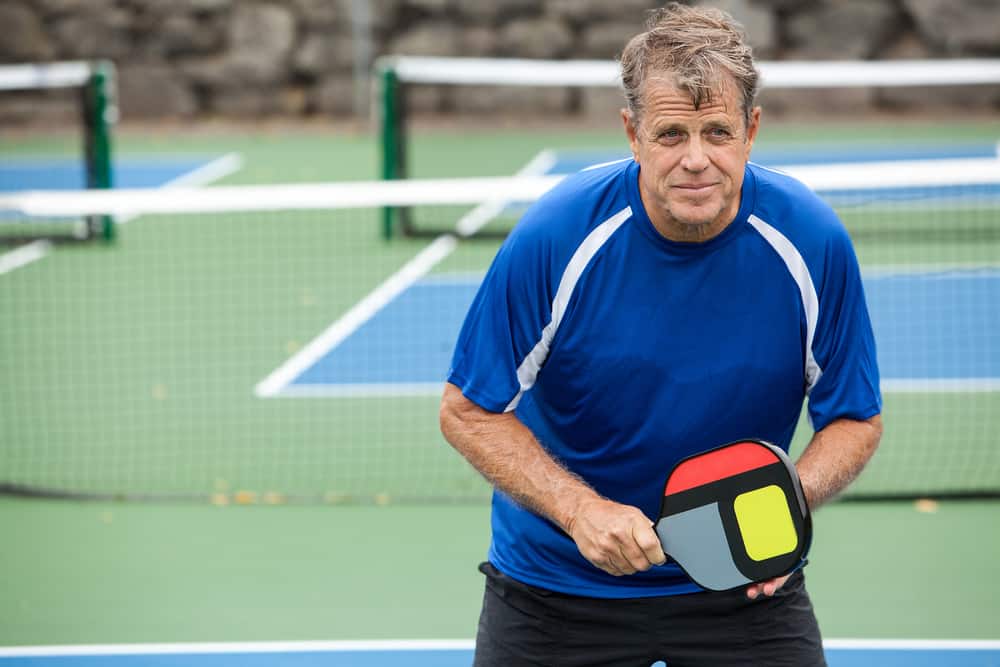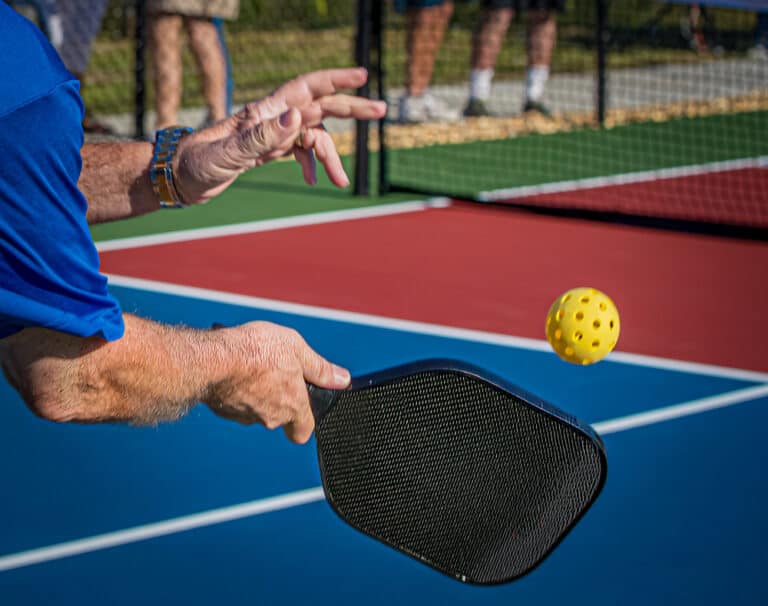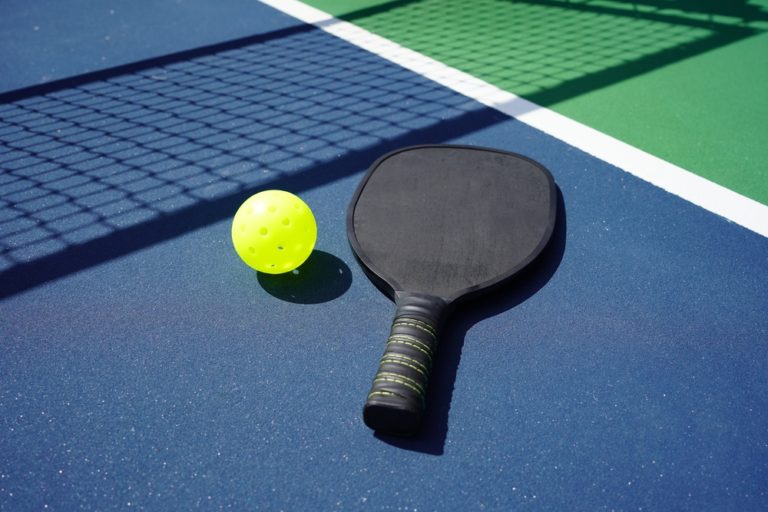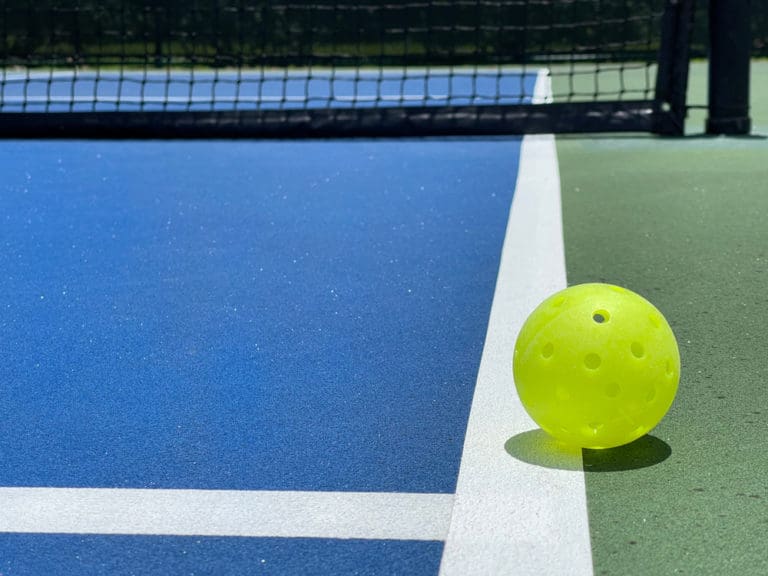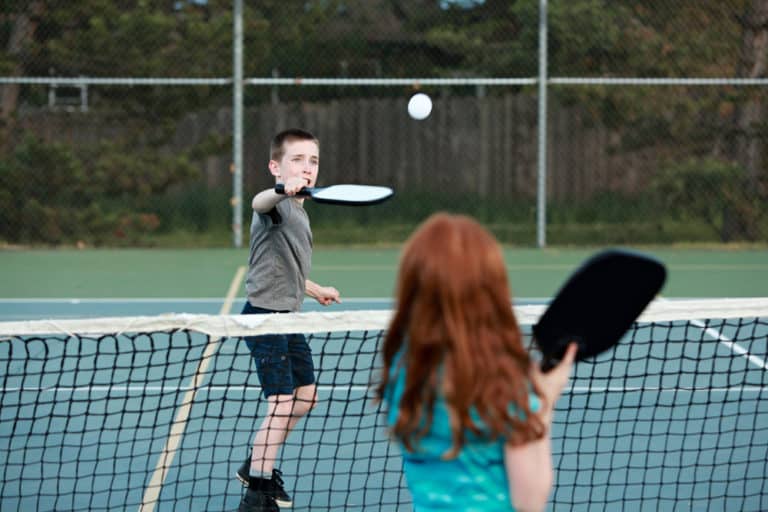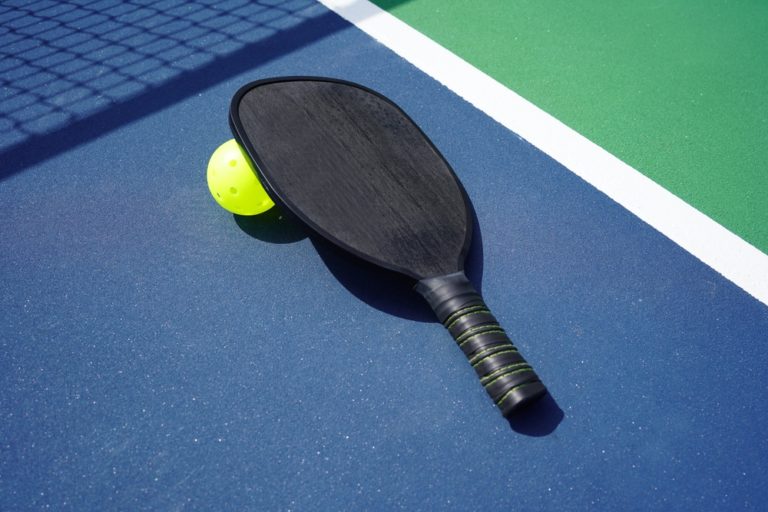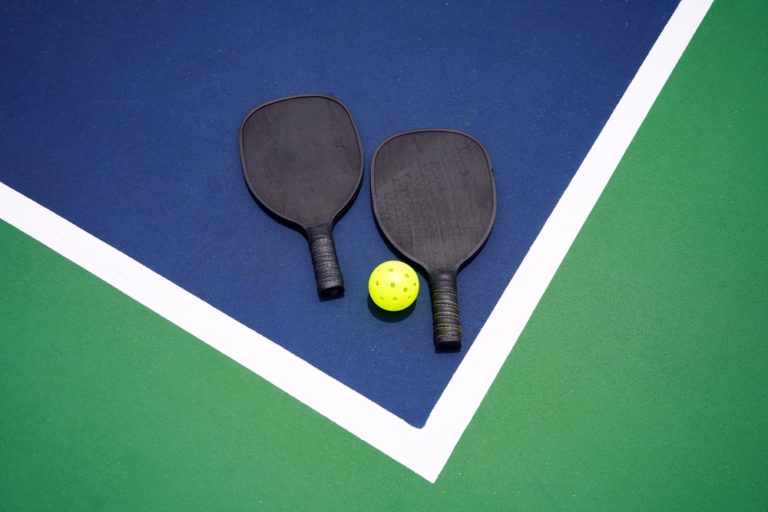Is It Better To Have A Lighter Or Heavier Pickleball Paddle?
It might appear logical to favor a lightweight pickleball paddle, but a heavier paddle is also advantageous. I prefer a balance between the two, yet my two pickleball friends are at odds about power and control. So, which weight option is the better alternative?
A lighter pickleball paddle is better for players who favor maneuverability and finesse. Although it’s light, it can be tough on your joints because you need to swing harder. Heavier paddles have more power but lack control; they fatigue your wrists quickly and favor an aggressive playstyle.
A player’s preference often makes them unique, making some opponents harder than others. Let’s examine these differences, specifically looking at their paddle weight. We’ll see what advantages and disadvantages each offer, how they affect your performance on the court, and the small details that will help you make the right choice for your own game.
Is It Better To Have A Lighter Or Heavier Pickleball Paddle?
When you consider the weight of your paddle, you must remember that a paddle can be heaviest at the top (head-heavy) and heaviest at the bottom (handle-heavy). Together, these weights make up the swing weight of a paddle.
A Pickleball Paddle Has Swing Weight
The concept of swing weight is crucial because it can affect your arm depending on the torque behind the paddle when you swing it.
The swing weight of the paddle will consist of its gross weight plus how heavy the paddle is at its head region. Combining these two elements will give you an estimate of the kind of swing weight you should consider.
It’s important to distinguish that swing weight is not the same as the total mass of the paddle. For example, two different paddles can weigh 7.5 ounces, but their swing weight can be entirely different because one is head-heavy (heavier at the top), while the other is handle-heavy (heavier at the bottom).
Typically, longer paddles have a higher swing weight than shorter ones because they are usually head-heavy. When you swing a heavier paddle through the air, it will exert more force and generate a more powerful hit than something significantly more lightweight. For example, a paddle made from paper won’t have nearly the same amount of power as a graphite paddle.
In such a case, more powerful shots will impart more torque and resistance between the ball and the paddle, so you will be much more likely to feel the impact run into your hands, wrists, forearms, and elbows. Thus, playing pickleball for extended periods will tire your hand more quickly and cause potential injuries.
How Would Head-Heavy And Handle-Heavy Paddles Play?
If you were to swing a mini-sledgehammer around the court for three hours, there is a high risk of hurting your wrist. At the same time, maneuvering such a heavy object is more complicated and requires immense strength and well-established muscle memory to maintain a steady playing performance.
On the contrary, going onto the court with a feather will have you swinging for hours with minimal effort and risk of injury to your wrist, forearms, or elbows. Of course, lighter paddles will also mean less power behind every shot, but you gain more control and finesse.
Swingweight will affect each individual differently due to our body size or type. If you’re a player that has powerful arms and makes excellent power shots, you may want to consider a paddle that provides more control and precision to introduce a little order into your playstyle.
Similarly, some players may want more power behind their shots and opt for a head-heavy paddle.
How Do You Know Which Swing Weight Is Best For You?
You can decide on a suitable swing weight by doing a quick little experiment.
- Take the paddle you wish to try and grip it in your hand without clenching your closed hand.
- Ensure that your arm and elbow are not tense, and swing the paddle from left to right, letting it follow its own movement rather than having your hand or arm move it.
- Get a good feel for the motion: it may feel like you’re dragging it through water or pulling something from the paddle’s head area. That said, you may not feel this kind of resistance.
If you experience the water effect and feel some resistance, you’re dealing with a head-heavy paddle. If there’s little resistance when the paddle moves from left to right, it’s a handle-heavy paddle.
Typically, singles players opt for head-heavy paddles because they require more power to drive the ball forward and deeper onto the opposition’s side of the court. Since fewer people are on the court than in doubles, defensive capabilities are less prominent, and an offensive playstyle is more effective.
Players who play doubles will prefer a paddle that is not so head-heavy, making it easier to swing and maneuver around the court. Since there are more bodies on the court during a doubles game, there are more variables to respond to, so the extra mobility can be invaluable. Lightweight paddles allow for easier dinks, lobs, and better control during volleys at the kitchen.
Can You Make Your Pickleball Paddle Heavier?
If you discover you need a little more weight to even out your game, you’ll be happy to know you can use lead tape to add a whole ounce to your paddle. In fact, the USAPA (USA Pickleball Association) does not place weight restrictions on pickleball paddles. Additionally, lead tape and edge guard tape are permissible to change the size, grip, or markings on a pickleball paddle.
Why Would You Want To Make Your Paddle Heavier?
When you apply lead tape to your paddle heavier, giving you considerably more power on aggressive shots like overheads, drives, and volleys. Furthermore, it can enhance your technique by adding additional spin to your balls while improving your ability to dink and block, improving your overall defense against an opponent’s power shots.
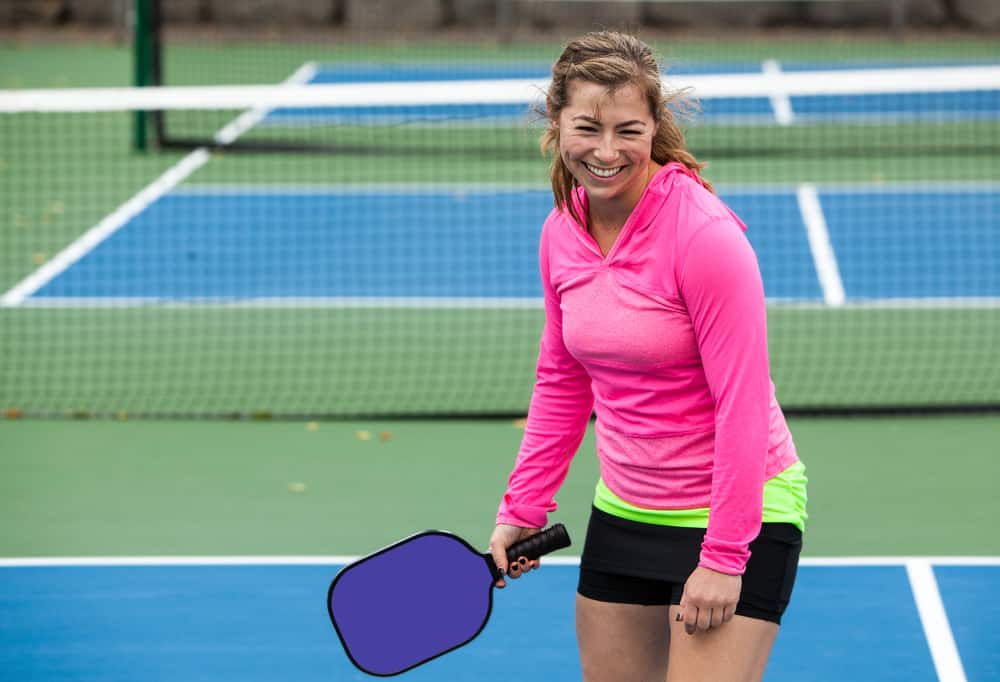
What Determines A Good Pickleball Paddle Weight?
If you pick a pickleball paddle that is too heavy (e.g., 10 ounces), it will be impossible to make a success of it. In fact, you will most likely suffer from elbow pain, and your wrist will become tired quickly.
Thus, you want to find your fit by considering a paddle’s weight range. The most practical way to get a sense of your ideal paddle weight range is to try as many different paddles as possible. Ask a friend or loved one who has a collection and ask them whether you can try your hand.
If you find a paddle that you like, research it online, discover its weight range, and write it down. Afterward, try playing with a paddle that is too heavy, or that feels uncomfortable, and follow the same procedure by writing down its weight range. The process will help you figure out what weight range is too light for you and what range is too heavy.
Why Can Both Extremes Be Bad For You?
If you’re not an advanced player and have aspirations to improve, know that a heavier paddle will reduce your mobility and hinder your improvement rate. It will make you slower to react, and you won’t be able to position yourself correctly for certain shots.
When your paddle is too heavy, you will lose a lot of maneuverability and flexibility needed to make you competitive on the court.
When you use a pickleball paddle that is too lightweight, you are effectively crippling yourself in terms of power and opportunity. Your shots will carry less power and pose only a minor threat to the opposition. For this reason, finding your weight range is a critical part of your pickleball paddle game and can very well determine the outcome of a game before it even starts.
Consider The Core Of A Pickleball Paddle
Today, most pickleball paddles consist of a polymer (plastic) core, which offers a balanced weight range and supports a controlled and aggressive playstyle.
Two other core types are aluminum and Nomex, but they are scarce and don’t usually appear in pickleball paddles. Aluminum is very light, focusing on providing maximum control and finesse but offering very little in terms of power.
On the other hand, Nomex cores are the opposite of aluminum and focus heavily on power. They offer little to no control and are thus ideal for players that enjoy an aggressive playstyle. It produces a lot of pop, so defending with a Nomex core is problematic because it makes it tough to guide the ball or even predict where it will bounce.
Do Professionals Use Heavy Or Light Pickleball Paddles?
There is no actual right or wrong in paddle weights; some pros prefer the maneuverability of a lighter paddle, while others like to overwhelm their opponent with powerful shots. Professional pickleball players are just like ordinary players, except they give more thought to why they do something.
What Paddle Does Tyson McGuffin Use?
Tyson McGuffin uses the Selkirk AMPED Invikta Paddle, a paddle in the heavier 7.9 – 8.3 ounce weight range, because he is strong and likes to bang hard ground shots.
The Amped Invikta has a more prominent sweet spot than standard elongated paddles. The enormous sweet spot, extended surface area, and long handle enable complete court control and power.
The Tyson McGuffin Signature Edition, averaging 8.1 ounces for increased power on hard drives from the baseline, was designed by the top pro player and national champion Tyson McGuffin.
What Paddle Does Benjamin Johns Use?
Benjamin Johns uses the Franklin Ben Johns Signature 16mm Pickleball Paddle and finds itself in the middleweight range between 7.6 and 8.1 ounces.
With MaxGrit technology, this paddle pushes the boundaries by providing the most incredible texture levels permitted by USA Pickleball, allowing for deadly amounts of spin.
A fiberglass-hitting surface also delivers an ideal blend of power and control, while an enormous sweet spot maintains consistency no matter where the ball makes contact. The 16mm thick core offers a smooth and responsive feel on impact, and the USAPA has certified it as a competitive and tournament-worthy paddle.
What Paddle Does Anna Leigh Waters Use?
Anna Leigh Waters uses the Paddletek Bantam TS-5. It is at the bottom of the weight spectrum, with a 7.0 and 7.5 ounces weight range. Anna Leigh may prefer a more controlled playstyle with quick hands and finesse rather than strength and aggression.
This paddle is ideal for the quick-handed, fast-rallying control player and is lighter than the Bantam EX-L. The TS-5 sports a responsive polymer core and a ball-crushing fiberglass-hitting surface, much like its larger sibling. It enables rapid swings and unrivaled response speeds.
What Paddle Does Catherine Parenteau Use?
Catherine Parenteau has long been a fan of Tempest Pro paddles. The paddle feels a lot more like a tennis racket, which is reassuring since she used to be a tennis player. It also makes her feel more comfortable with her topspin and rolls.
She also likes how it gives her a sense of strength without causing her to lose control of her swing. The paddle makes it easier for her to make 2-handed backhand strokes, giving her more space between herself and the ball.
She also noted that now that she has more space between herself and the ball, her passing strokes are significantly improved; she can reach balls that were previously difficult to reach or even touch.
Can Paddle Weight Help Relieve Medical Conditions?
If you have arthritis, “tennis elbow,” or a hand, elbow, or shoulder ailment, a middleweight paddle between 7.3 and 8.4 ounces can be an invaluable boon. It will be hefty enough to give stability and absorb shock while being light enough not to put undue stress on your arm.
Swinging a paddle heavier than 8.4 ounces might aggravate an injury or arthritis in those with hand, elbow, or shoulder issues, especially while defensively blocking and volleying when you are swiftly moving your paddle to defend or block and attack during a volley. As a result, almost all wood paddles are risky for such players.
So, what about lightweight paddles? Because there is less mass in the paddle to absorb energy and vibration, a lightweight paddle will force you to put a lot of energy, swing, and momentum into each contact with the ball. Lighter paddles require players to swing harder to put energy into their shots, placing extra strain on their joints.
Thus, it’s vital to find the perfect weight range for you as a player to maximize your performance while caring for your body.
Conclusion
Go for a lighter paddle if you want a more forgiving paddle on your joints and offer more control and the ability to position yourself more easily on the court. A heavier paddle provides much more powerful shots at the cost of controlling where you want the ball to go. It’s also more taxing on the wrist and forearms.
Sources
- https://www.youtube.com/watch?v=ObVt_02BZAc&ab_channel=In2Pickle
- https://thepickler.com/blogs/pickleball-blog/pickleball-lead-tape
- https://www.youtube.com/watch?v=R6vMj912Cqw&ab_channel=PickleballKitchen
- https://www.reddit.com/r/Pickleball/comments/ocwuzm/paddle_weights_of_pros/
- https://pickleball.global/ranking/gentlemen
- https://www.totalpickleball.com/Selkirk_AMPED_Invikta_Paddle_Tyson_McGuffin/descpage-SAIPTMP.html
- https://www.totalpickleball.com/Franklin_Ben_Johns_Signature_16mm_Pickleball_Paddle/descpage-FRBJ16.html
- https://pickleball.global/ranking/gentlemen
- https://www.totalpickleball.com/Paddletek_Bantam_TS-5_Paddle_Anna_Leigh_Waters/descpage-TKBALW.html#:~:text=Designed%20with%20National%20Champion%20Anna,%2C%20fast%2Drallying%20control%20player.
- https://www.pickleballcentral.com/Paddletek_Tempest_Reign_Pro_Graphite_Paddle_p/ptk500.htm#:~:text=Top%20professional%20pickleball%20player%20Catherine,how%20it’s%20changed%20her%20game
- https://annapolispickleballclub.wildapricot.org/page-18083/6971483?tpg=2

